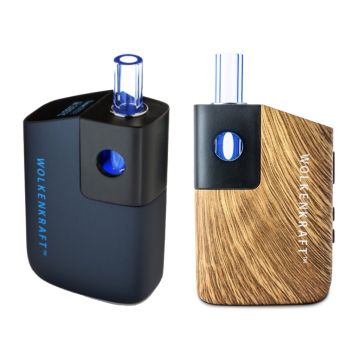Conduction or Convection Vaporizer?
You can heat using various techniques. If the heating source is in direct contact with the herb chamber or the concentrate, the substances evaporate by means of conductivity. Or with a more convenient word: conduction. Convection vaporizers allow hot air to flow past and through the contents of the vaporizer when you take a puff. There are various advantages and disadvantages of both vaporizers, but as a rule of thumb the most important differences are the heating time, purity of flavour and completeness of vaporization of the contents.
- Convection vaporizers often give the purest taste. Especially with an insulated vapour channel.
- Conduction vaporizers often have a shorter heat-up time than convection vaporizers, making your device ready for use faster.
- There are also hybrid vaporizers that use both techniques. This allows them to heat up even faster, and the taste of the vapour is retained longer in subsequent sessions. However, these vaporizers are often more expensive. These vaporizers are mentioned in both categories.
- The cheapest vaporizers use a simple statement: "No need for electric heating". Flame against it and go! Such a simple glass or metal vaporizer prevents the herbs from burning when you hold a lighter to it, but you have no control over the vaporizer temperature. You'll also find these vaporizers in the conduction category.
How does a Convection Vaporizer work?
A convection vaporizer works on hot air. The air which is sucked in through the mouthpiece is heated in a different place than with conduction vaporizers. The air is heated before it reaches the contents of the herb chamber. This warm air flows, as it were, through the weed or herbs and absorbs the volatile substances such as cannabinoids and terpenes. Then it goes into the hose or balloon where it has the opportunity to cool down again before it enters your mouth through the mouthpiece.
Advantages of Convection Vaporizers
This type of hot air vaporizer has a number of advantages over vaporizers that use conduction heat:
- Pure air that ensures the vapour tastes of the vaporizer’s contents (and not of the vaporizer itself) - especially with a glass or a gold (leaf) vapour channel.
- Weed or herbs are heated evenly, so hot edges and unvaporized bits are not a problem.
- The sensitive heating element doesn’t require cleaning as the content doesn’t come into contact with the element.
Disadvantages of Convection Vaporizers
- Often somewhat more expensive than conduction vaporizers.
- Bigger in size due to longer vapour channel and larger battery. Accordingly, less economical with energy.
- Little choice of portable models.
Hybrid Vaporizer
With both conduction and convection techniques, hybrid vaporizers are a combination of the two. As a result, the herb chambers are often larger in size. Are these units the best option then? Check out the pros and cons and make up your own mind:
Advantages of Hybrid Vaporizers
- Both pure vapour and dense clouds. Hot air ensures that all the contents are heated evenly and the direct heating produces the powerful hit that smokers find great.
- You regulate the intensity of the hit by means of reliable temperature control.
- Modern models can even be very small.
- High-quality device and easier to clean than conduction vaporizers.
Disadvantages of Hybrid Vaporizers
- Expensive price range.
- Limited choice of different models.
